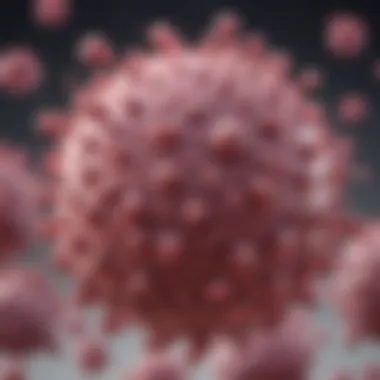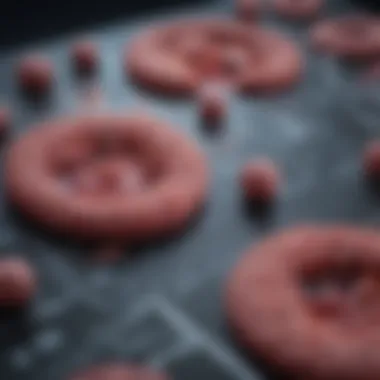Understanding Eosinophils: Health Implications Revealed


Intro
Eosinophils are a unique type of white blood cells that play crucial roles in the immune system. These cells are particularly well-known for their involvement in allergic reactions and combating parasitic infections. Understanding eosinophils is vital because their behavior can inform clinical practices and patient management in various conditions. This article delves into the implications of eosinophil levels, their diagnostic relevance, and how they fit into broader medical contexts.
Key Findings
Eosinophils can indicate several health conditions. First, signs of elevated eosinophil counts are often linked to allergic disorders, such as asthma, hay fever, and eczema. They can also be elevated in cases of parasitic infections, where they help the body respond to and eliminate parasites.
Another important aspect is the connection between eosinophils and autoimmune diseases. Conditions like eosinophilic esophagitis and hypereosinophilia present significant clinical challenges, highlighting the need for accurate diagnostic criteria. Recent studies show that understanding the regulation of eosinophils can lead to better-targeted therapies.
Summary of the Main Results
- Elevated eosinophils: Correlate with allergic reactions and parasitic infections.
- Autoimmune diseases: Eosinophils play a role in conditions like eosinophilic esophagitis.
- Regulation of eosinophils: Research points to potential therapies based on eosinophil regulation.
Significance of Findings within the Scientific Community
The implications of these findings extend into many areas of medicine. Eosinophils are more than just responders; they influence the immune system's behavior and possibly its long-term outcomes. Understanding their developmental biology could pave the way for innovative treatments targeting immune responses.
Implications of the Research
Examining eosinophils expands knowledge in immunology and clinical practice. Heightened eosinophil counts are not just numbers; they can inform treatment strategies and patient outcomes.
Applications of Findings in Real-world Scenarios
- Clinical diagnostics: Measuring eosinophil levels helps determine the presence of allergies or infections.
- Treatment plans: Knowledge of eosinophil behavior assists in designing tailored therapies for patients with allergy-related conditions.
Potential Impact on Future Research Directions
Future studies may explore the genetic factors influencing eosinophil behavior, examining how these cells can be regulated to prevent or treat various disorders.
Further understanding of eosinophils not only provides insights into allergic conditions but also opens avenues for addressing complex immune disorders.
Prelims to Eosinophils
Eosinophils are a specialized subset of white blood cells, playing a crucial role in various immune responses. Understanding these cells is essential, especially as they are increasingly linked to allergic diseases and infections. This section sets the stage for a detailed exploration into what eosinophils signify in clinical terms.
Eosinophils are often considered indicators of immune activity. Their presence in elevated numbers can point to several health conditions. The examination of these cells is vital for diagnosing and monitoring such conditions. The intricate relationship between eosinophils and the immune system underscores their relevance in both health and disease.
Definition and Classification
Eosinophils are classified as granulocytes, a type of white blood cell distinguished by the granules present in their cytoplasm. They originate from the bone marrow and are characterized by their bi-lobed nuclei. The primary role of eosinophils involves the defense against parasites and modulation of allergic reactions.
Eosinophils can be found in various tissues throughout the body, particularly in the lungs, gastrointestinal tract, and skin. They are typically identified in blood smears for diagnostic purposes. Elevated levels of eosinophils, known as eosinophilia, can suggest underlying pathology such as allergies or parasitic infections.
Role in the Immune System
Eosinophils contribute significantly to the immune system’s functionality. Their primary role is to combat parasitic infections by releasing cytotoxic granules that damage the membranes of parasites. Moreover, eosinophils are involved in inflammatory responses, producing cytokines and chemokines that recruit other immune cells. This helps to amplify the immune response when necessary, but it can also lead to tissue damage in cases of chronic inflammation or allergic conditions.
"Eosinophils are not only key players in defense against parasites but also involved in complex interactions in allergic responses."
Eosinophil Characteristics
Eosinophils play a vital role in immunology, and understanding their characteristics is essential for recognizing their functions and implications in various health conditions. This section delves into the morphological features of eosinophils and their production and lifespan, which are critical for understanding how these cells respond to environmental stimuli and pathogens.
Morphological Features


Eosinophils have distinct morphological features that set them apart from other white blood cells. Typically, they possess a bilobed nucleus, which can be observed under the microscope. This structural attribute contributes to their classification as granulocytes. The cytoplasm of eosinophils is noted for the presence of numerous granules, which are rich in enzymes and proteins essential for their function in the immune system.
These granules stain well with acidic dyes, giving eosinophils their name. They generally appear in shades of orange to red when subjected to certain staining techniques. This distinctive coloration is a hallmark during laboratory examinations, aiding in identification by hematologists and clinicians.
Additionally, the cellular size of eosinophils is generally larger compared to other leukocytes, with a diameter of about 12-17 micrometers. Their shape and granule content indicate their readiness to respond to allergens or parasitic infections, highlighting their dual role in both defense and regulation of inflammation.
Production and Lifespan
Eosinophils originate primarily from myeloid progenitor cells in the bone marrow. The process of eosinophil production, known as eosinopoiesis, involves several stages, with growth factor stimulation. Key factors such as interleukin-5 (IL-5) play a significant role in this process, promoting differentiation and maturation.
After entering circulation, eosinophils have a relatively short lifespan of about eight to 14 days. However, they can be activated and survive longer in tissues, especially during inflammatory reactions. This brief lifespan is crucial as it allows eosinophils to respond quickly to invaders and allergens, but also necessitates a constant supply from the bone marrow to maintain normal physiological levels.
Overall, understanding these characteristics of eosinophils provides insight into their roles in both health and disease, emphasizing their significance in medical diagnostics and treatment strategies.
"The careful study of eosinophil characteristics paves the way for unraveling their complexities in various pathologies and therapeutic responses."
By elucidating how these cells function and interact within the immune system, we can better appreciate their implication in allergic reactions, asthma, and other inflammatory conditions.
Eosinophil Functionality
Eosinophils play a crucial role in the immune system, particularly in the context of allergic reactions and parasitic infections. Their functionality is a reflection of their ability to combat certain pathogens and regulate inflammatory responses. This section will explore key elements behind the mechanisms of action of eosinophils, and their interactions with other immune cells, providing insights into their significance in various health conditions.
Mechanisms of Action
Eosinophils exert their effects through a variety of mechanisms. One of the primary functions involves the release of cytotoxic granules. These granules contain proteins and enzymes that can damage parasites and infected host cells. Major basic protein and eosinophil peroxidase are examples of such proteins. When eosinophils encounter a target such as a parasitic organism, these granules are released into the surrounding area. This action can help neutralize threats efficiently.
Additionally, eosinophils have the capability to produce reactive oxygen species. These molecules can lead to cell damage in pathogens, which enhances the effectiveness of the immune response. They are also involved in the synthesis of various cytokines, including interleukin-5, which plays a role in the growth and activation of eosinophils themselves, as well as the activation of other immune cells.
Another important aspect of eosinophil functionality is their role in modulating inflammation. High levels of eosinophils can contribute to the progression of chronic inflammatory diseases. Their actions can be both protective and detrimental, emphasizing the need for a balanced eosinophilic response.
The functionality of eosinophils underscores their dual role in providing defense against parasites and participating in inflammatory processes, highlighting their significance in clinical assessments.
Interaction with Other Immune Cells
Eosinophils do not act alone; they engage with a range of other immune cells to maintain homeostasis and respond effectively to infections. For instance, they have a well-documented interaction with T helper cells, particularly T cells. These cells release cytokines that promote eosinophil proliferation and activation, leading to an enhanced immune response.
In addition to T cells, eosinophils work alongside mast cells. Both cell types can be activated during allergic reactions, releasing histamines and other mediators that contribute to the inflammatory process. This interaction can demonstrate the complexity of immune responses during pathological conditions.
Furthermore, eosinophils can communicate with dendritic cells and macrophages. Information exchange through cytokines can influence the activity of these cells in various immune pathways. This communication facilitates a coordinated response to infections and may play a role in the development of autoimmune disorders.
Lastly, understanding the interactions between eosinophils and other immune cells can inform treatment approaches for conditions related to eosinophilia. Clarifying the roles of these cells in disease pathogenesis could lead to better-targeted therapies.
Clinical Relevance of Eosinophils
Eosinophils play a critical role in various medical conditions, making their clinical relevance noteworthy. Understanding their functions and implications helps health professionals establish better diagnostic and treatment strategies. This section will shed light on normal eosinophil levels and what their elevation signifies in clinical practice. A clear insight into these aspects aids in managing conditions associated with eosinophilia.
Normal Eosinophil Levels
Normal eosinophil levels range from 0 to 500 cells per microliter of blood. These cells are typically present in small amounts in healthy individuals. Their primary function includes combating parasitic infections and participating in allergic responses. Maintaining eosinophil levels within the normal range is essential for optimal immune function.
Elevated Eosinophil Levels: Implications
Elevated eosinophil levels, known as eosinophilia, can indicate underlying health issues. This can occur due to various factors, such as allergic reactions, infections, or autoimmune diseases.


Here are some implications of elevated eosinophil levels:
- First, they may signal an allergic response, potentially indicating asthma or other allergic disorders.
- Second, elevated levels can reflect parasitic infections, particularly in endemic areas.
- Finally, in some cases, they may link to certain malignancies. Thus, assessing eosinophil levels is crucial in diagnosing and managing various conditions.
Conditions Associated with Eosinophilia
Eosinophilia is commonly associated with several health conditions, including:
Allergic Reactions
Allergic reactions often trigger increased eosinophil production. This response can manifest in conditions such as allergic rhinitis and asthma. The key characteristic of allergic reactions is the immune system's abnormal response to normally harmless substances. In the context of eosinophilia, this hyperactivity represents the body's attempt to eliminate perceived threats. However, this can also lead to tissue damage and chronic inflammation.
Parasitic Infections
Parasitic infections represent another area where elevated eosinophil levels are significant. Eosinophils target and attach to parasites, aiding in their destruction. The unique feature of these infections is that they commonly provoke a substantial immune response, often resulting in high eosinophil counts. This connection makes parasitic infections a critical area of focus when evaluating eosinophil levels. Such links offer potential for targeted treatments, though they also emphasize the need for thorough diagnosis and continued monitoring.
Autoimmune Diseases
Some autoimmune diseases can cause elevated eosinophil levels. The immune system mistakenly attacks healthy tissues, leading to inflammation and tissue damage. In conditions like eosinophilic granulomatosis with polyangiitis, eosinophils contribute to the disease process. Recognizing eosinophilia in autoimmune diseases is vital, as it affects treatment plans.
Certain Malignancies
Certain malignancies also correlate with increased eosinophil levels. Diseases such as Hodgkin lymphoma and some types of leukemia can involve elevated eosinophils. The characteristic of these malignancies often includes a complex interplay of immune system alterations. This link emphasizes the importance of comprehensive evaluation in patients presenting with eosinophilia.
Diagnostic Approaches
Evaluating eosinophil levels is crucial for diagnosing various health conditions. Eosinophils can indicate underlying allergies, infections, or other disorders. Therefore, selecting appropriate diagnostic approaches helps in understanding a patient’s health status accurately. The main goal is to identify any abnormalities with eosinophils that may necessitate further investigation or treatment.
Blood Tests and Eosinophil Count
Blood tests are among the primary methods for assessing eosinophil levels. A complete blood count (CBC) often involves measuring the number of eosinophils present in a blood sample. Normal eosinophil levels usually range from 0 to 450 cells per microliter. When eosinophil counts exceed this range, it is referred to as eosinophilia.
The significance of monitoring eosinophil count includes:
- Identifying health issues: Elevated levels can indicate allergic reactions or parasitic infections.
- Tracking disease progression: Regular testing can help observe how conditions change over time or in response to treatments.
- Guiding clinical decisions: Test results may inform treatment plans or the need for further investigations.
A simple blood test is relatively quick and non-invasive, making it accessible for both patients and healthcare providers. It provides immediate insight into eosinophil levels and can help establish a baseline for future comparisons.
Bone Marrow Biopsy
While blood tests provide valuable information, they may not reflect the full picture of eosinophil dynamics. A bone marrow biopsy may be necessary when eosinophil levels are significantly elevated or when eosinophilic disorders are suspected.
A bone marrow biopsy involves:
- Extracting a sample: A small amount of bone marrow is removed, usually from the hip bone.
- Analyzing eosinophils: The sample is examined for abnormal eosinophil production or maturation issues.
This procedure can help rule out conditions such as eosinophilic leukemia, where dysfunctional eosinophils proliferate uncontrollably. Although more invasive than blood tests, marrow sampling can yield essential insights if discrepancies in eosinophil levels occur.
Imaging Techniques
In addition to blood tests and biopsies, various imaging techniques may assist in the diagnosis of eosinophil-related conditions. These methods can identify potential underlying causes of elevated eosinophils or locate associated issues within the body.
Common imaging techniques include:


- X-rays: Useful for visualizing structural anomalies, particularly in cases with respiratory or allergic concerns.
- CT scans: Offer more detailed views of organs like the lungs or abdomen, helping identify infections or tumors.
- Ultrasound: Can assess organs and lymph nodes for enlargement or other abnormalities linked to eosinophilia.
These imaging modalities complement blood tests by providing a broader understanding of health conditions possibly related to eosinophil levels.
In summary, diagnostic approaches for evaluating eosinophils encompass a range of methods. From simple blood tests to more complex imaging and biopsies, each technique plays a role in forming a complete picture of a patient's health. This multi-faceted strategy is critical for effective diagnosis and management of eosinophil-related disorders.
Management of Eosinophil-Related Conditions
Effective management of conditions related to eosinophils is crucial for both patients and healthcare providers. Eosinophils, as a type of white blood cell, play a significant role in the immune system, particularly concerning allergies and parasitic infections. The elevation or dysregulation of eosinophil levels can indicate a variety of health issues ranging from benign reactions to severe diseases. Understanding management strategies helps in mitigating symptoms and addressing underlying causes.
Treatment Options for Elevated Eosinophils
When eosinophil levels rise beyond normal, identifying the cause is essential before treatment begins. Several strategies may be employed:
- Corticosteroids: These drugs are often the first line of treatment. Corticosteroids decrease inflammation and reduce eosinophil production. They can be administered systemically or as localized treatments.
- Biologics: Agents such as mepolizumab and reslizumab target specific pathways involved in eosinophil production and activity. These can be beneficial for conditions like asthma or other eosinophilic disorders.
- Antihistamines: For allergy-related eosinophilia, antihistamines can alleviate symptoms and help manage the immune response.
- Immunosuppressants: In cases where eosinophilia is linked to autoimmune diseases, immunosuppressants might be necessary to control overactive immune responses.
Each treatment option comes with considerations regarding efficacy and potential side effects. Individualized treatment plans, based on a thorough assessment of the patient's specific condition and health history, are vital for optimal outcomes.
Monitoring and Follow-Up
Monitoring eosinophil levels and evaluating treatment effectiveness are fundamental aspects of managing these conditions. Regular blood tests can help assess eosinophil counts over time. Some important points in monitoring include:
- Regular Check-ups: Follow-up appointments should be scheduled to track changes in eosinophil levels and adjust treatments accordingly.
- Symptom Tracking: Patients should record any symptoms or side effects, enabling healthcare providers to fine-tune treatment plans effectively.
- Threshold values: Knowing the normal range for eosinophils in the blood assists practitioners in making informed decisions about necessary interventions.
"Effective management requires not just treatment, but also an understanding of the underlying conditions influencing eosinophil levels."
Proper management leads to reduced symptoms and better quality of life. Engaging in ongoing dialogue between patient and provider is essential for long-term success with eosinophil-related conditions.
Research and Future Directions
Research into eosinophils is increasingly vital due to their complex roles in various physiological and pathological processes. Understanding eosinophils has implications not only for treating allergies and infections but also for other conditions where these cells are involved. This section will cover important emerging studies and potential therapeutic targets that can enhance our understanding and management of eosinophil-related disorders.
Emerging Studies on Eosinophils
Recent studies concerning eosinophils have begun to reveal new understandings of their functions beyond traditional views. These immune cells are not just participants in allergic responses; they may also play significant roles in chronic inflammation and tissue remodeling. Researchers are exploring the following avenues:
- Inflammatory diseases: Multiple studies suggest that eosinophils are involved in conditions like asthma, where they contribute to airway inflammation. Investigating the signaling pathways and cytokines that activate eosinophils could lead to better therapeutic strategies.
- Microbiome interactions: The relationship between eosinophils and the gut microbiome is gaining attention. Research indicates that eosinophils may respond to microbial signals, impacting immune responses.
- Eosinophil heterogeneity: Recent findings suggest that not all eosinophils are alike. Subpopulations of these cells may have unique roles and responses in different tissues or conditions. Understanding this variability is crucial in pinpointing their functions.
Research also points to eosinophils being involved in responses to viral infections, which adds a layer of complexity to their role in immunity. As more studies unravel these connections, they could shift the clinical approach toward not just viewing eosinophils as mere bystanders in allergic reactions, but as key players in various disease mechanisms.
Potential Therapeutic Targets
Identifying therapeutic targets related to eosinophils offers the potential to refine treatment options for conditions associated with abnormal eosinophil levels. Several promising targets have emerged from current research:
- Cytokine inhibitors: Targeting specific cytokines involved in eosinophil activation, such as IL-5, has shown to be effective in treating eosinophilic asthma. Antibody therapies like mepolizumab and reslizumab are now FDA-approved for managing severe asthma by inhibiting IL-5.
- Eosinophil signaling pathways: Researchers are looking at pathways that regulate eosinophil survival and activation. Inhibiting these pathways might reduce eosinophil-mediated tissue damage in conditions like eosinophilic esophagitis.
- Biologics and small-molecule drugs: Novel biologics targeting eosinophils are in various stages of development. These treatments hold promise for conditions stemming from elevated eosinophil levels.
In addition to these specific targets, there is an emphasis on developing personalized medicine approaches that take into account individual variations in eosinophil function and response. Continued research will refine these potential interventions, potentially reshaping therapeutic strategies in immunology.
"Eosinophils are not merely innocent bystanders; they are integral components of our immune response, with implications that span beyond allergies and infections."
By delving into these research directions, we hope to contribute to better management and a deeper understanding of eosinophil-related conditions.
Ending
In this article, we delved into the multifaceted roles of eosinophils within the human immune system. Understanding eosinophils and their implications is essential for both clinical practice and research. Eosinophils are not merely cellular components; they play a pivotal role in various immune responses, particularly in relation to allergies and parasitic infections.
Recognizing normal eosinophil levels helps to establish a baseline for health. Elevated eosinophil counts can indicate underlying health issues, leading to timely diagnosis and intervention. Conditions associated with eosinophilia, such as allergic reactions, parasitic infections, autoimmune diseases, and certain malignancies, emphasize the diverse implications of these cells.
The diagnostic approaches that include blood tests, bone marrow biopsies, and imaging techniques contribute to a clearer understanding of eosinophil-related disorders. Each method has its own advantages and can guide clinicians in making informed decisions. Furthermore, ongoing research into eosinophils highlights their potential therapeutic targets, opening avenues for innovative treatments in future medical practice.







